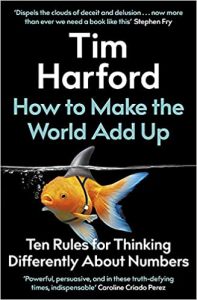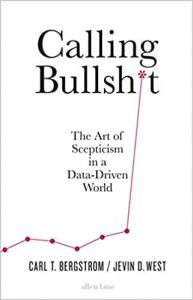As it happens, I’ve been reading two very similar books, with the mission of imparting critical thinking about statistics to their readers. One is Calling Bullshit: The Art of Scepticism in a Data-Driven World by Carl Bergstrom and Jevin West. The other is Tim Harford’s How To Make The World Add Up. Both are excellent – well-written, full of interesting or entertaining examples, absolutely what the world needs now. If only the people who most needed them would actually read them.
The two books do have a different focus. Bergstrom/West concerns statistical methods: how to interpret causal claims; understanding selection bias; good and bad data visualisation; big data bullshit. There is a fantastic quote from Charles Babbage, a propos of the garbage in, garbage out rule in data science: “On two occasions I have been asked, ‘Pray, Mr Babbage, if you put into the machine wrong figures, will the right answers come out. … I am not able rightly to apprehend the kind of confusion of ideas that could provoke such a question.”
Harford’s book is more about the habits of mind we bring to any numerical or statistical claims and is structured as a series of lessons: Pay attention to your emotional reaction – do you really want to believe (or not) a statistical claim? How representative is your personal experience when you think about a figure on social media or in the news? He is concerned to debunk the cynical idea that statistics always aim to manipulate or mislead us – sometimes they do, but statistics are also a vital tool for understanding and improving things, so the cynicism risks being corrosive.
I particularly like his rule “Avoid premature enumeration”, which asks you to consider how data were constructed – something many of us would do well to think about. For example, contrasts often result from different statistical classifications when the underlying realities are rather similar. The US does, for instance, have a higher rate of perinatal mortality than Finland but a large part of the difference between the two countries comes about because American doctors are more likely to classify a foetus of 22-23 weeks as a baby which subsequently died. There are chapters also on big data, and on the importance of transparency and data access.
Both books are really enjoyable reads, clear, great for students, or for 6th form general studies classes essential for journalists. I hope they do really well. If people followed the advice given by these authors, the world would be a better place.



I often use a line – I dont have attribution but it is rather good.
Statistics are often used in a way not unlike how a drunk uses a lampost – for support rather than illumination.